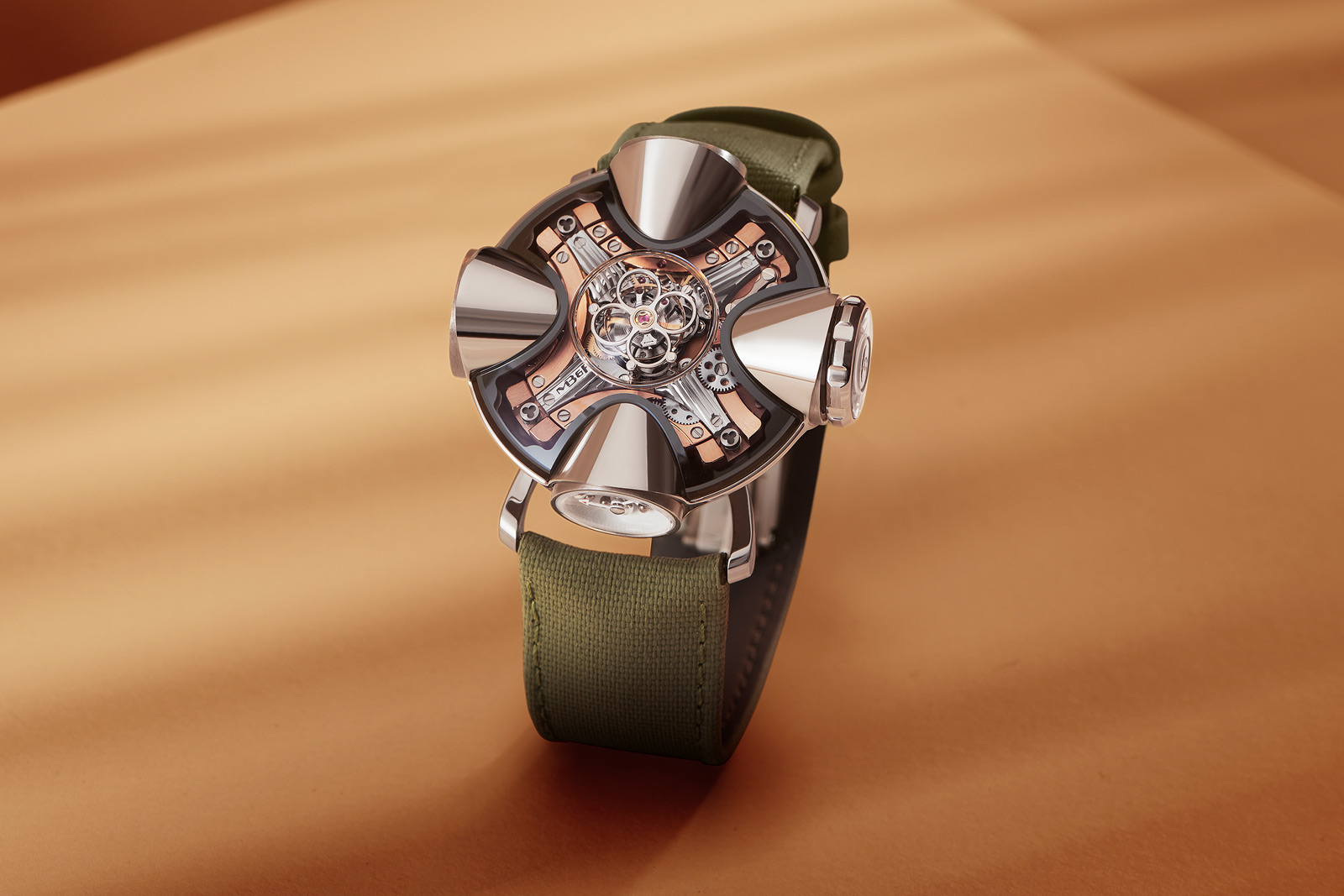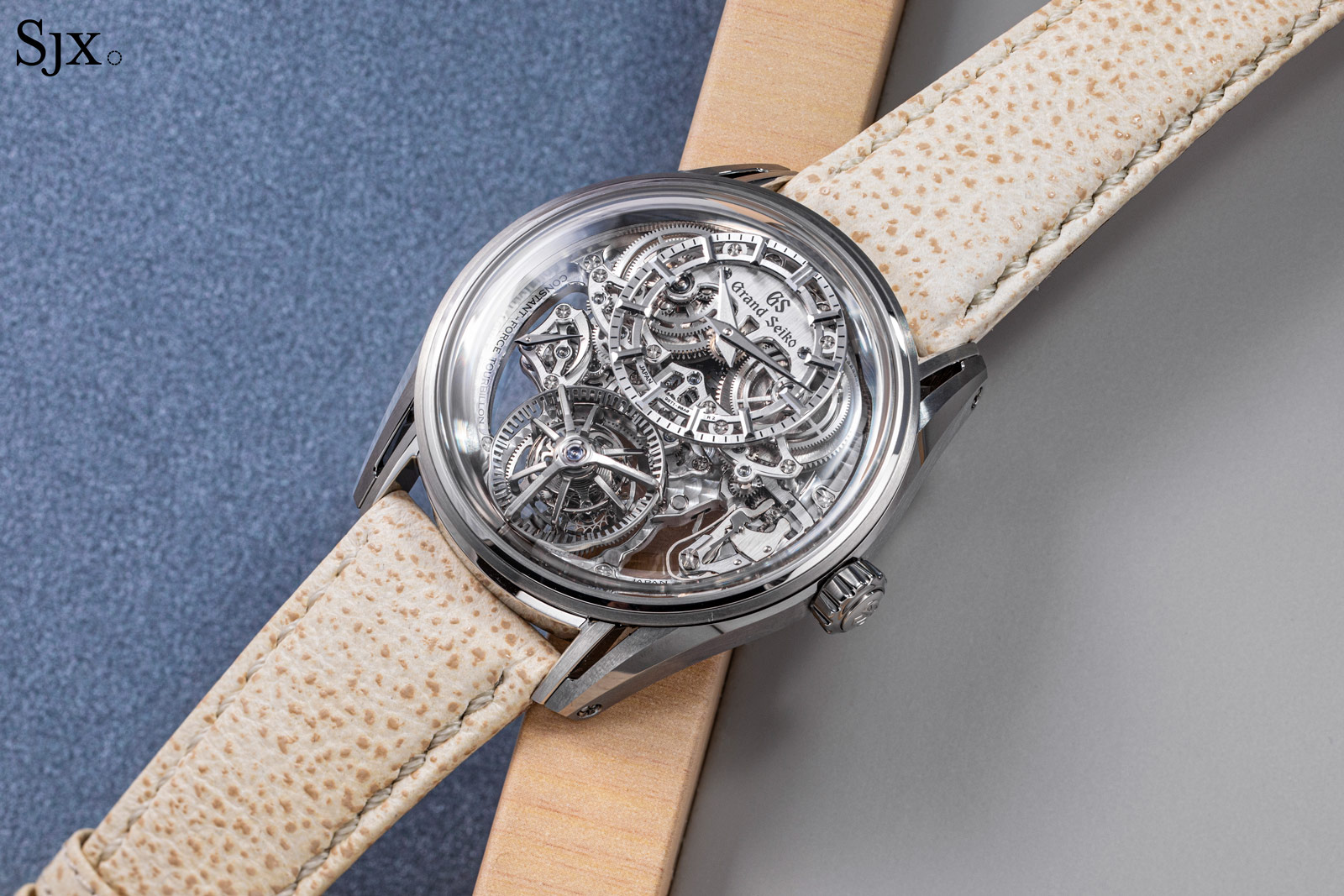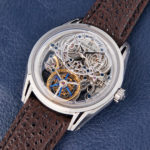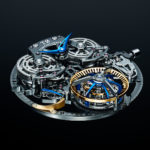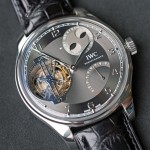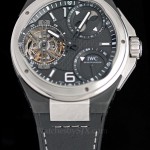Following the 2022 debut of its first ever tourbillon – and the brand’s most complicated watch ever – Grand Seiko follows up this year with the Kodo Constant-Force Tourbillon SLGT005 “Daybreak”. Mechanically identical to its predecessor (the SLGT003), the new Kodo still boasts a co-axial tourbillon and remontoir, a novel construction unique to the Kodo.
But the Kodo SLGT005 is dressed in brighter colours of silver tones and pale greys, hence the “Daybreak” nickname. The result is a watch that’s less aggressively technical in style, but just as complicated. And thanks to its lighter palette, the technicality and decoration of the movement are arguably more prominent in the Kodo “Daybreak”.
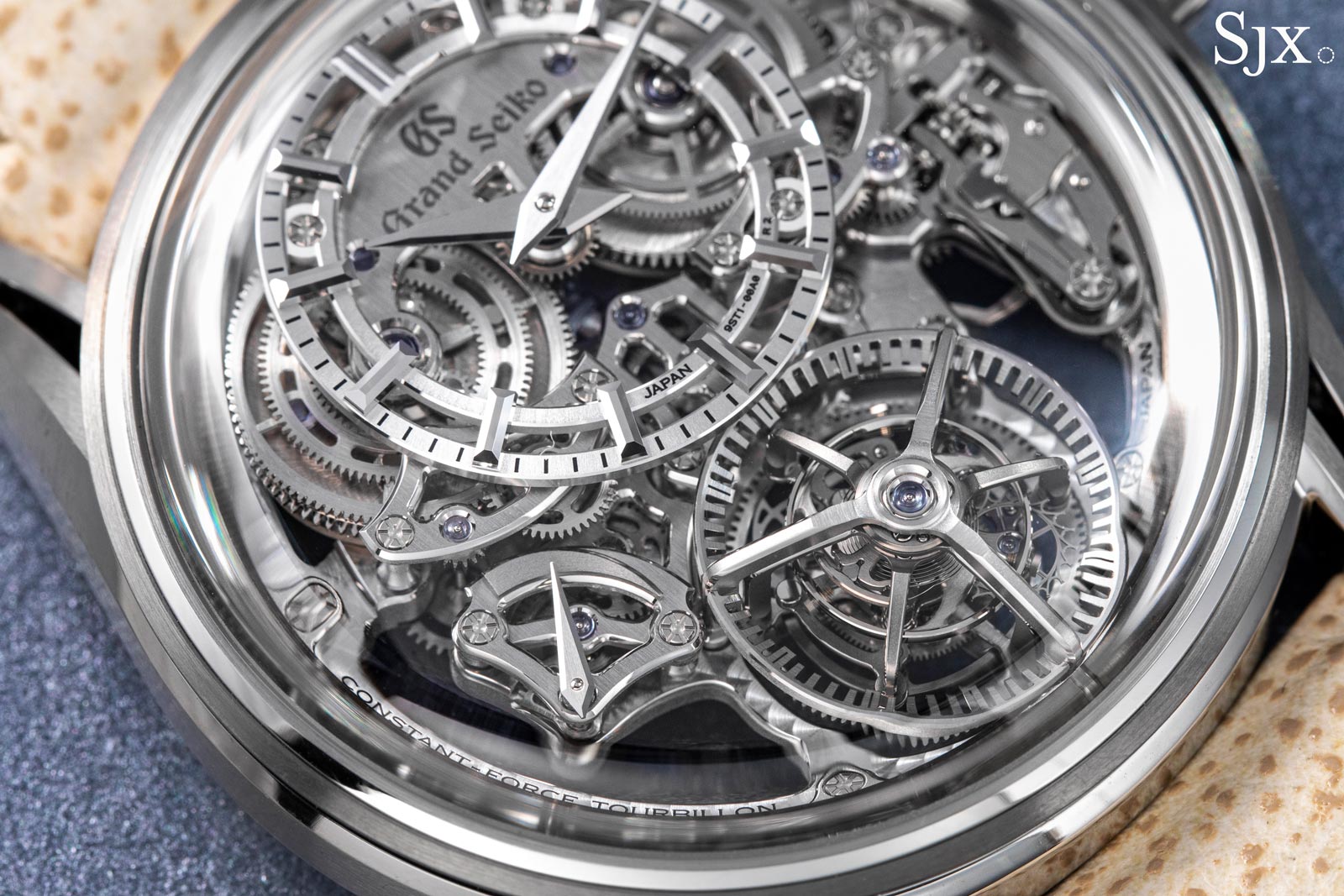
Initial thoughts
The Kodo in its original form had a strikingly skeletonised appearance that maximised the view of its intricate mechanics, giving something of an anime sci-fi aesthetic. This was accentuated by the dark colours highlighted with vivid, dark red rubies.
The new version, on the other hand, is both lighter in colour and visual weight. Because there’s less colour contrast in the movement, it appears a bit more classical and less stylised. A clever touch are the blue jewels to replace the conventional red ruby bearings, which enhances the “daylight” theme.
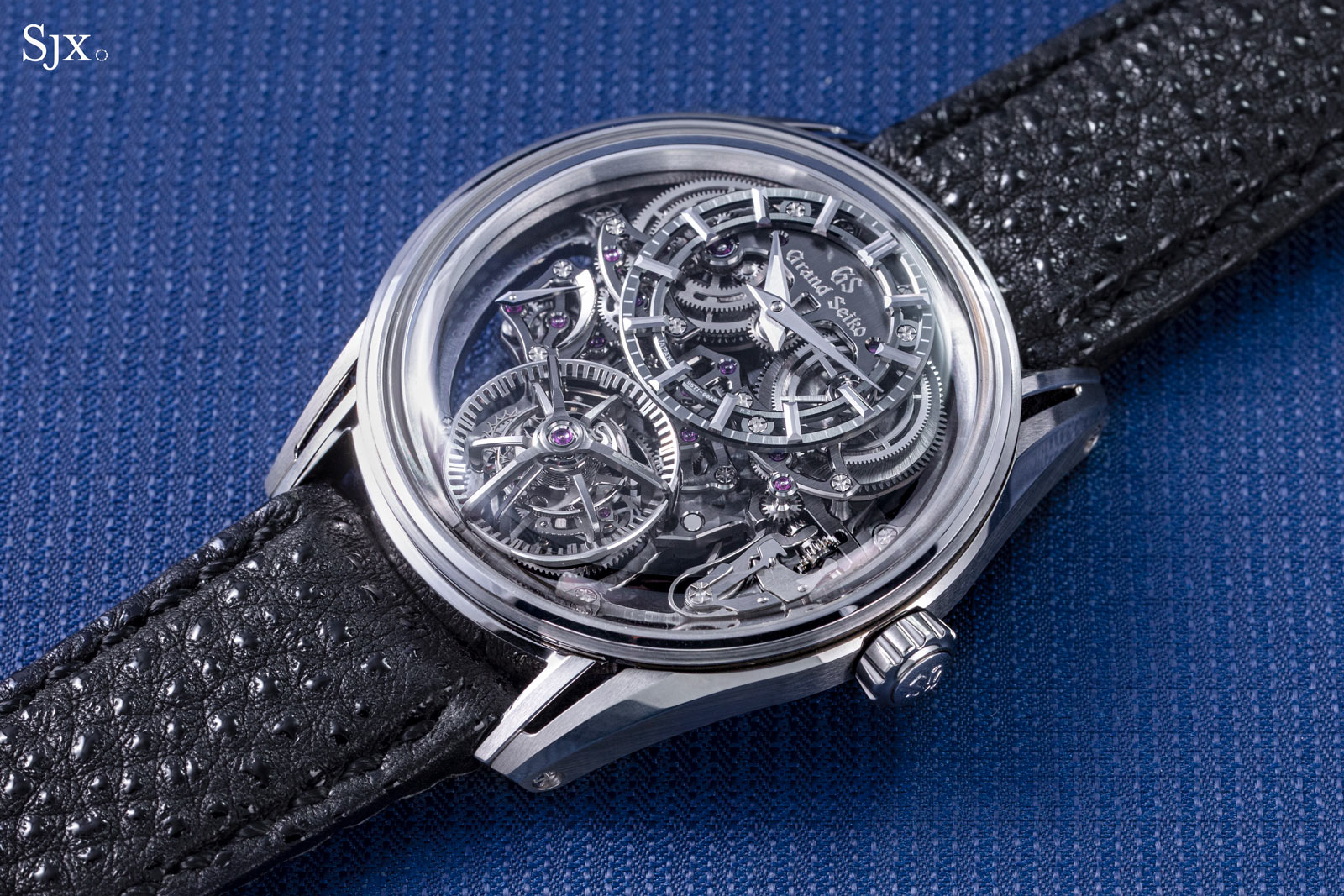
The original Kodo SLGT003 from 2022
Even though it looks different, the Kodo SLGT005 is identical in technical terms. So it still has the impressively constructed movement with a novel approach to the constant-force tourbillon. It is, in fact, an actual constant-force-tourbillon, with the remontoir superimposed on the tourbillon, as opposed to a tourbillon with a constant force device in the gear train or barrel.
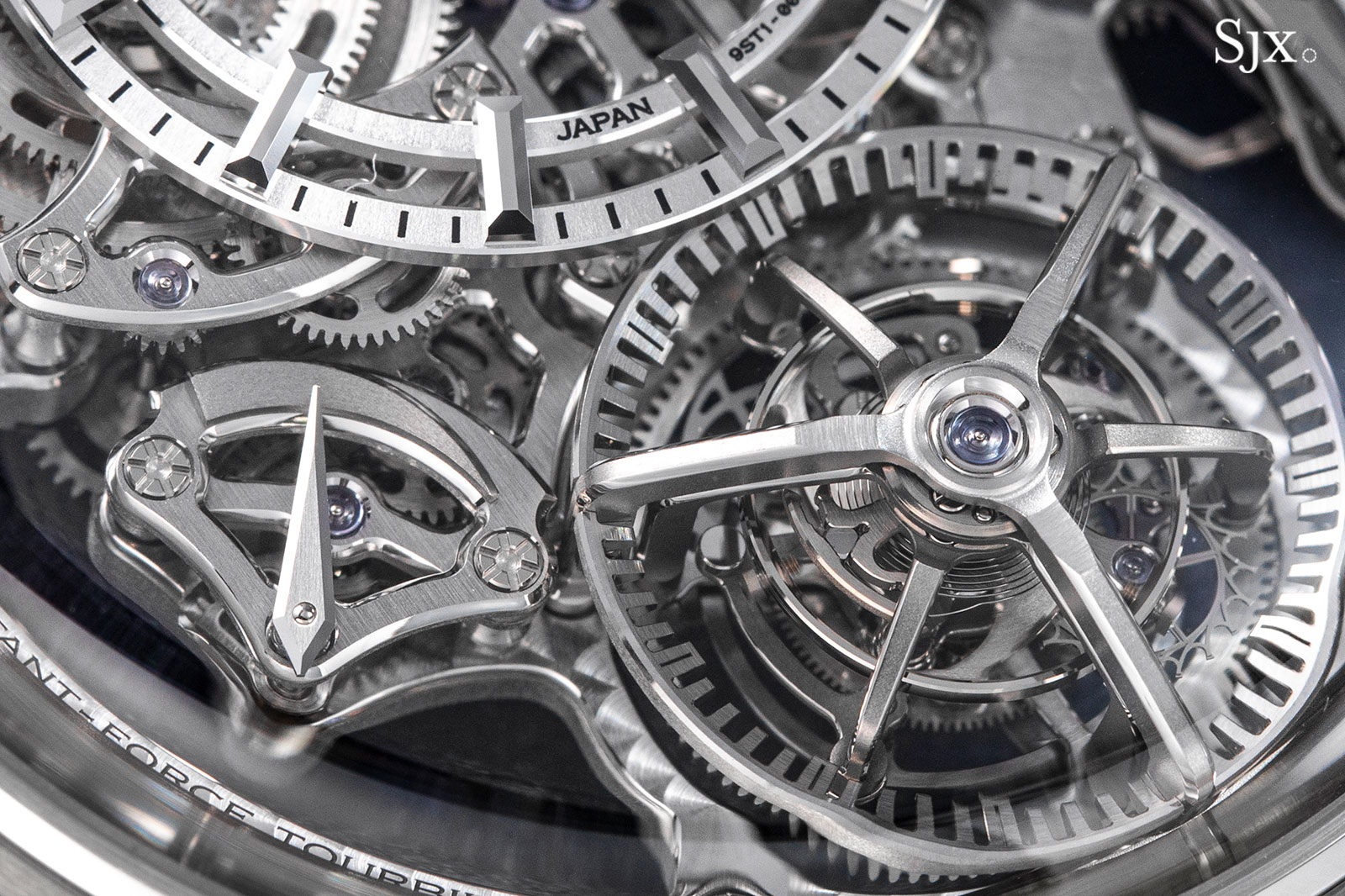
The constant-force tourbillon in the SLGT005, with the power reserve indicator to its left
The new finish colour makes it easier to observe the movement details and decoration, particularly on the front, which is dense and intricate, despite being skeletonised.
On the back, the difference is less pronounced as the movement layout is clearer. The reverse is almost monochromatic thanks to the blue jewels, giving it a desaturated appearance that tones down the sharp-angled details of the movement.
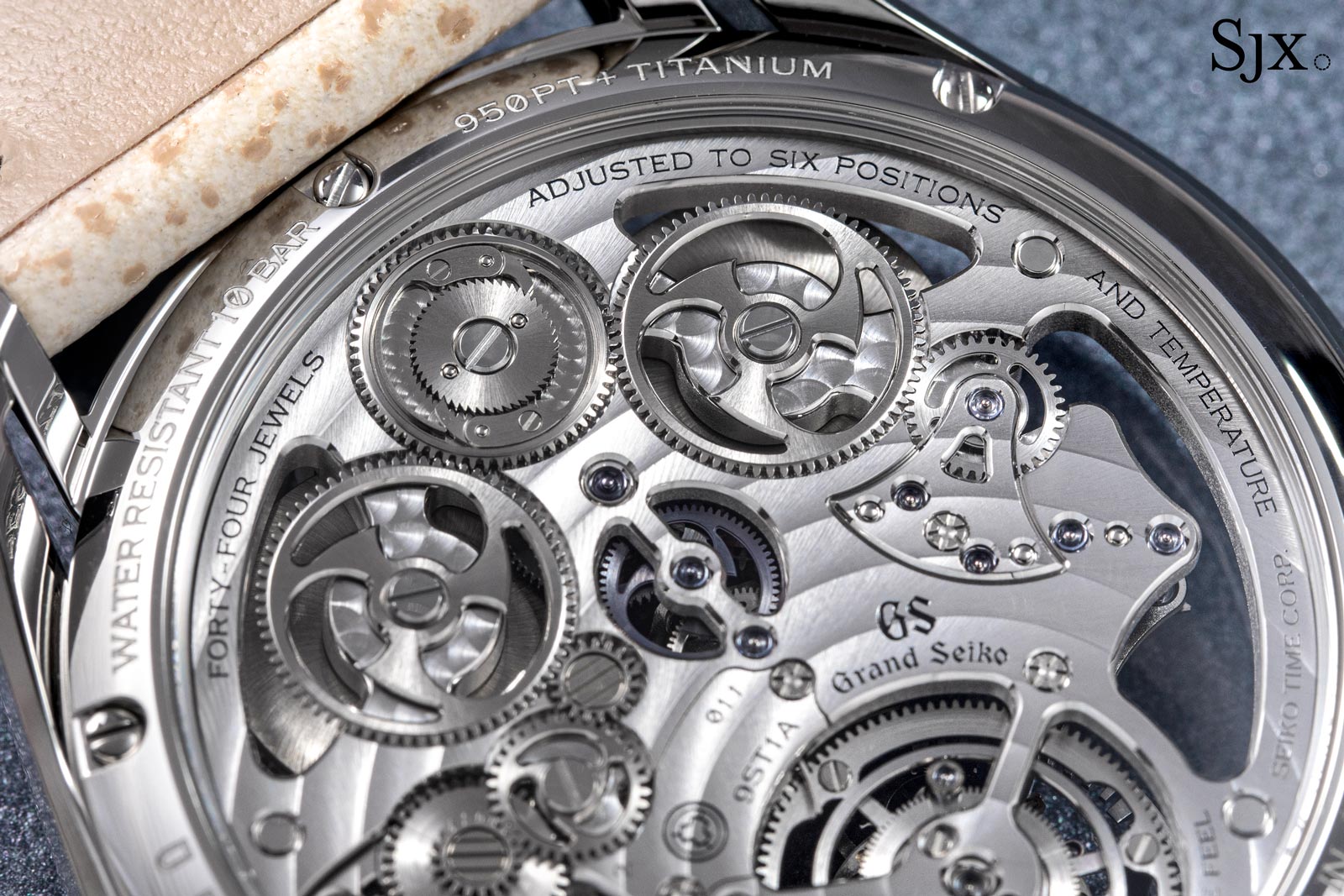
As an aside, one thing I dislike on the new Kodo is the strap. It’s a beige calfskin treated with natural lacquer using a traditional Japanese technique (the first Kodo had a similar strap but in black). The strap looks odd and doesn’t match the watch at all, at least in my eye. Fortunately, the watch is also delivered with a dark grey crocodile strap.
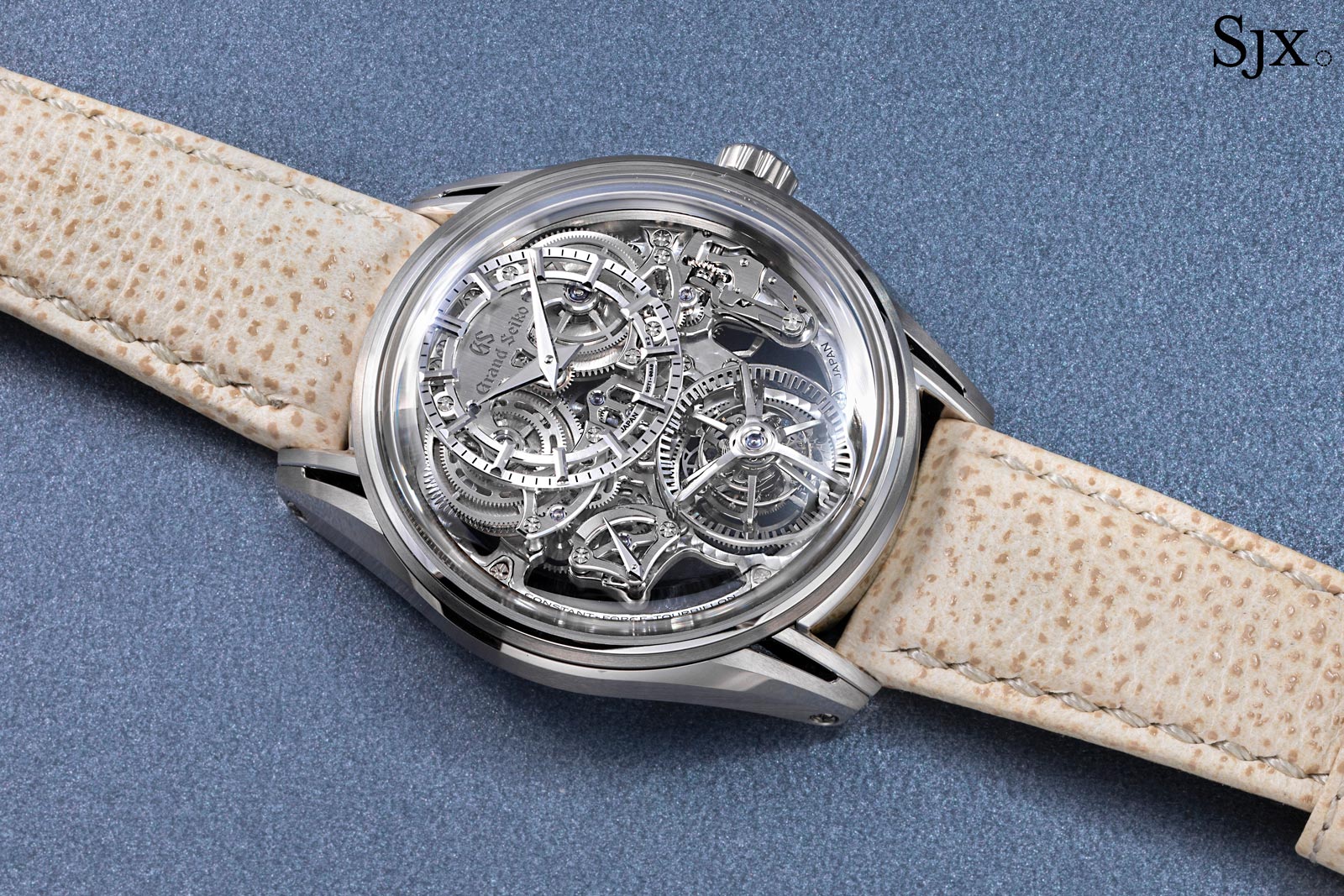
More broadly, and this is a criticism that applied to the original model as well, the hyper-technical aesthetic is not easily recognisable as Grand Seiko. Aside from the sharply-formed hands and hour markers, there is little that links this to the brand in terms of look and feel.
The brand has a traditional, even conservative house style that is well defined; the Kodo departs far from that. While the Kodo succeeds as an ultra-complicated chronometer that equals the best in watchmaking in terms of technical execution, its design is elaborate and thoughtful, yet not intrinsically distinctive.
Between the two versions, I would pick the Kodo “Daybreak” because the aesthetics appeal more. Priced at US$365,000 (or JPY45 million), the new Kodo is marginally more expensive than its predecessor in US dollar terms (with the disparity wider in yen due to the currency’s weakness). It’s difficult to rationalise a watch this expensive as worth it, but the Kodo certainly lives up to the price in terms of complication, construction, and finishing.
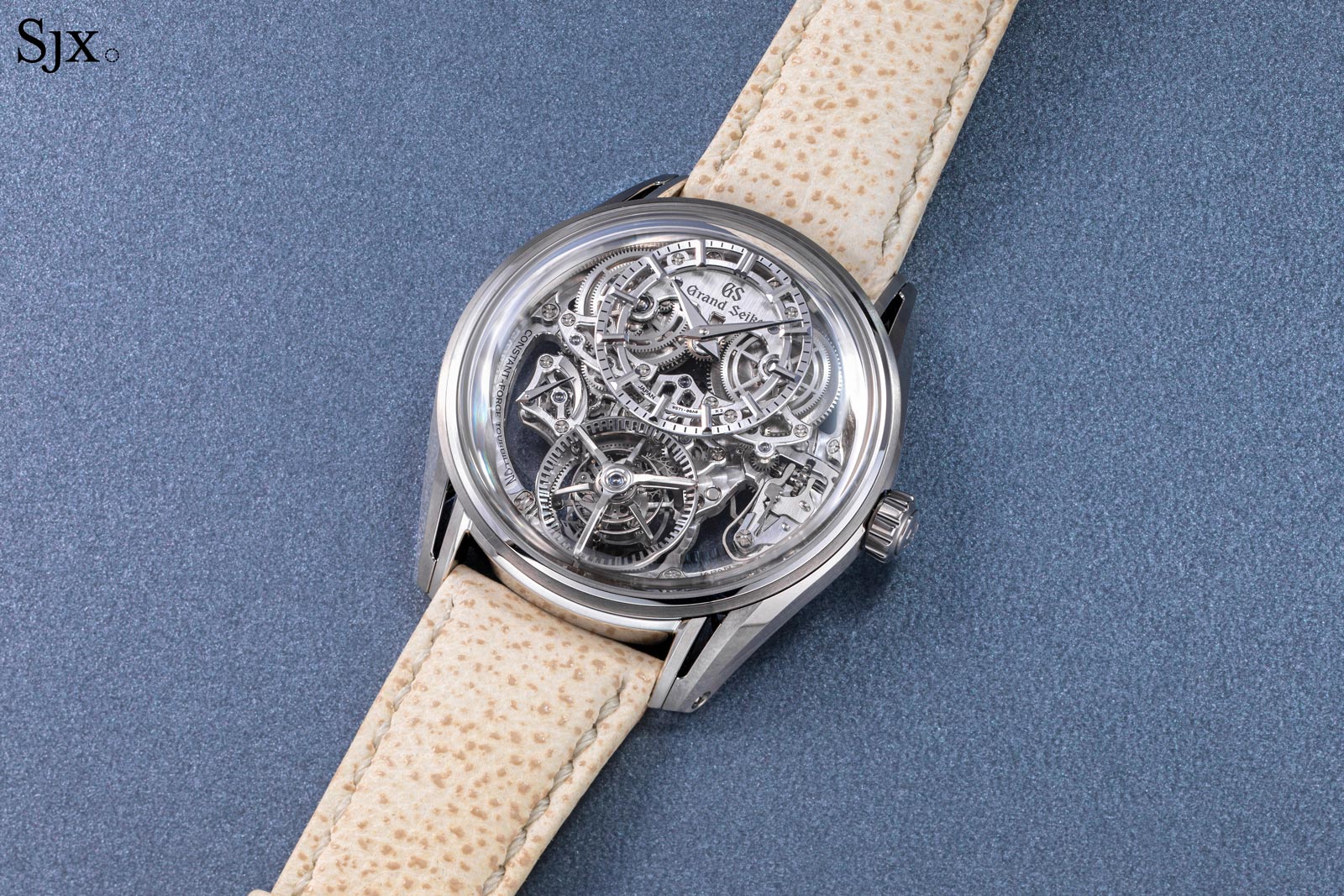
A brighter finish
The first Kodo was inspired by twilight, hence its darker finish. In contrast, the Kodo SLGT005 was conceived as the chromatic opposite inspired by morning. Instead of the dark grey finish (likely a ruthenium plating or similar), the Kodo “Daybreak” has a silvery tone across all the components, which is most probably the result of rhodium plating.
The blue jewels are a subtle but important detail that keep the colours of the watch coherent. Instead of conventional synthetic rubies, the jewels are synthetic sapphires, which do the same job of functioning as hard-wearing pivot bearings but do so in a faint blue hue.
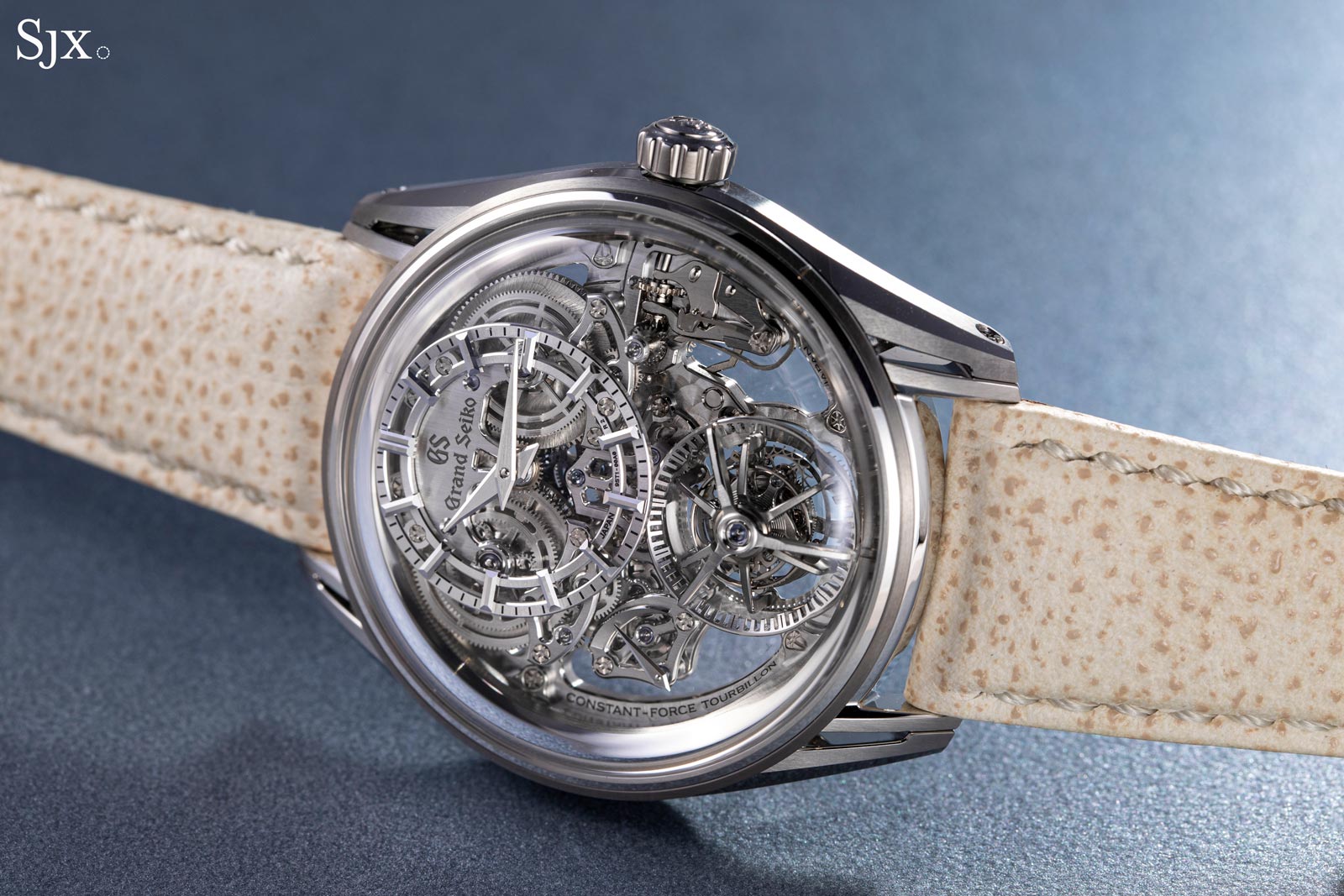
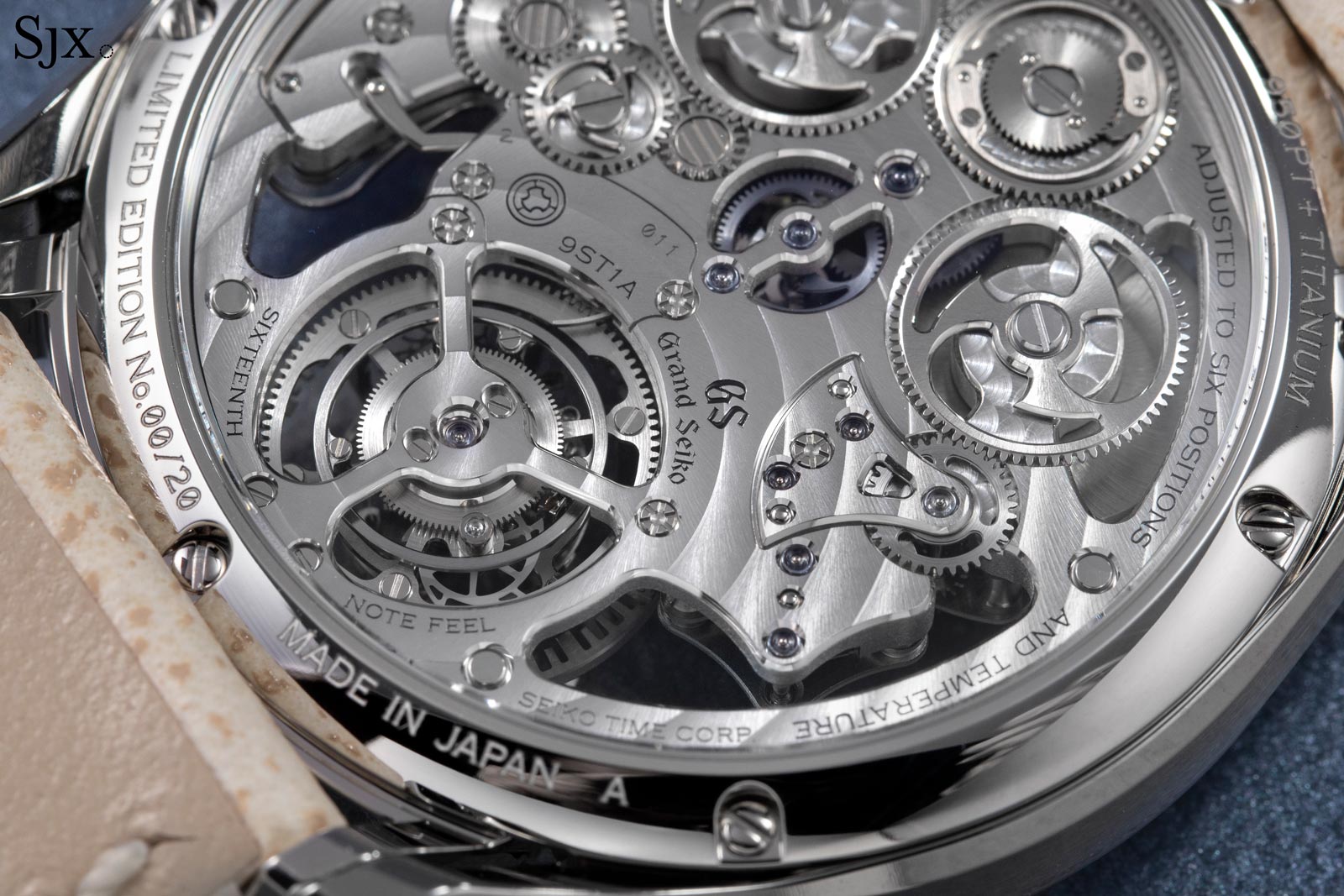
The case is identical to that on the original model, and large for a Grand Seiko. It measures almost 44 mm in diameter and just under 13 mm high, but has a surprisingly airy feel due to the skeletonised movement and open-worked lugs.
As before, the case is a two-metal combination of a platinum inner case with a Brilliant Hard Titanium outer case. The titanium alloy is proprietary to Grand Seiko and boasts a harder surface with a more silvery tone, giving it an appearance closer to steel than conventional titanium that is often grey.
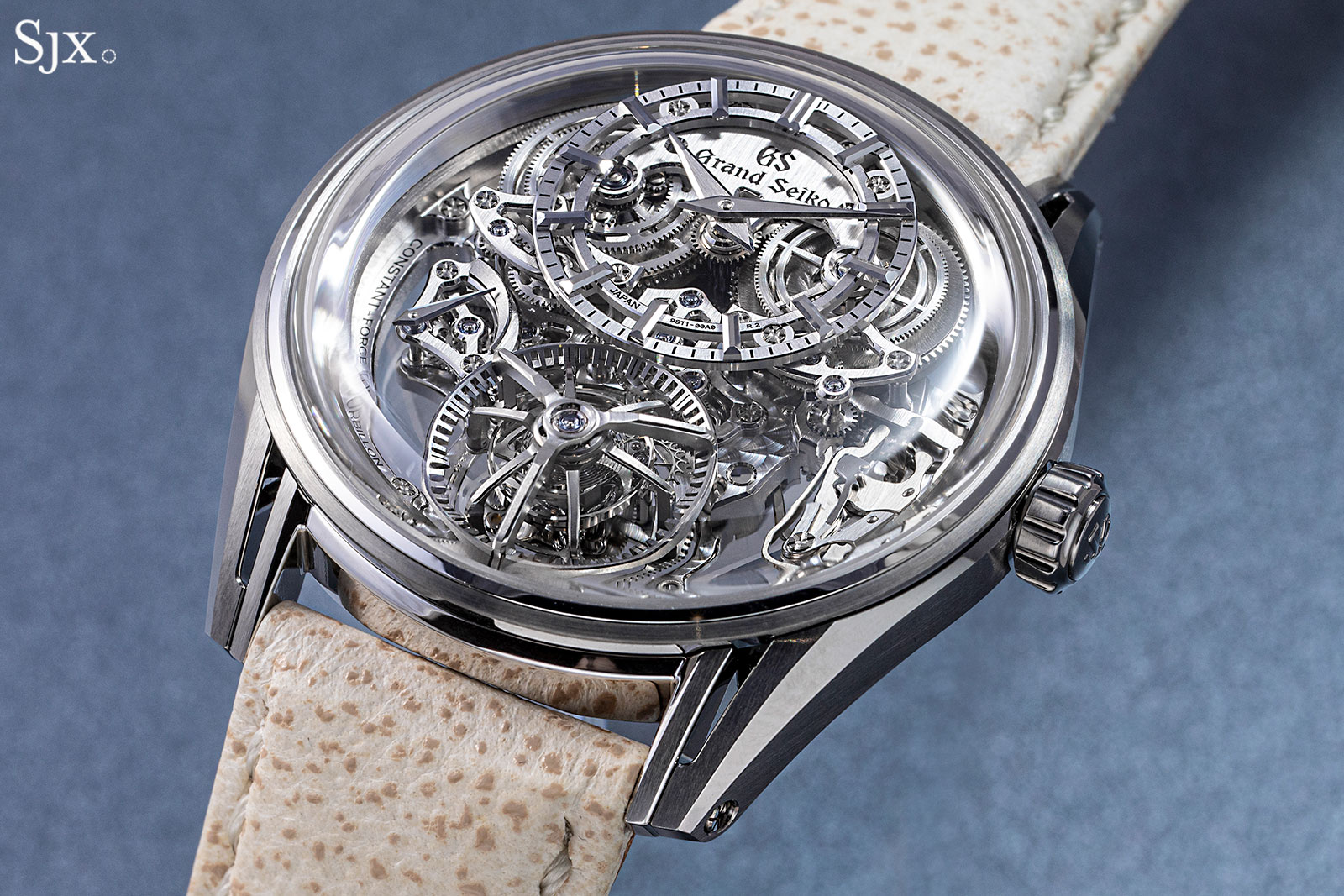
Both metals are finished with Grand Seiko Zaratsu technique of flat polishing, though some surfaces are subsequently finished with a matte brushing.
The quality of the polishing and the properties of Brilliant Hard Titanium are strikingly apparent with the Kodo, as it is difficult to discern a visual difference between the two metals on the wrist. The case could pass for being entirely in a single metal.
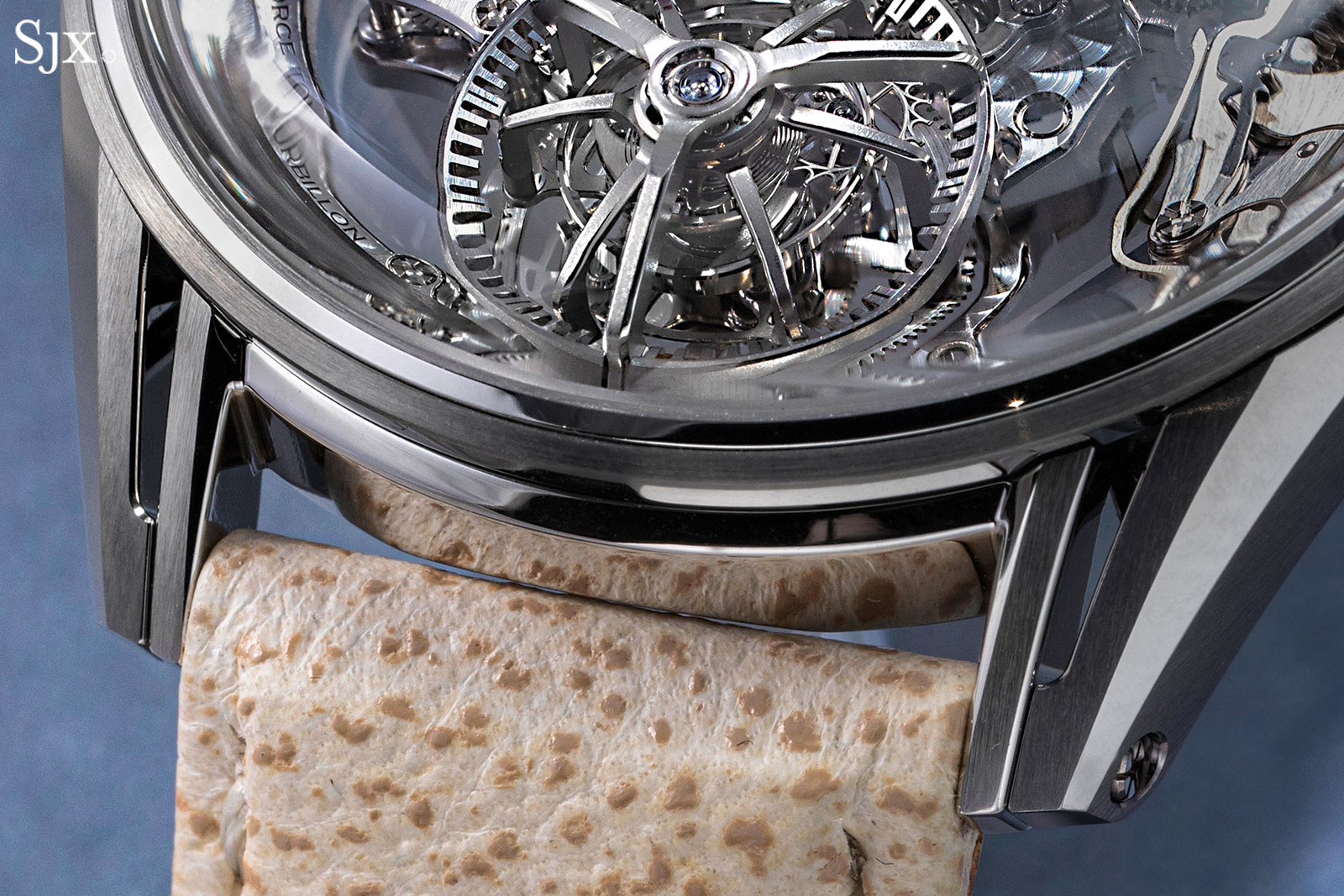
The cal. 9ST1
We already explained the Kodo and the cal. 9ST1 movement in great detail, but the watch can be summed up as one with a tourbillon with integrated constant force device, deadbeat seconds, power reserve indicator, and double barrels.
Because the movement is extensively skeletonised – it was actually developed as an open-worked movement – practically all of its mechanics are on display. The two large barrels are visible below the time-telling sub-dial, while the rack for the power reserve is visible just below its pointer.
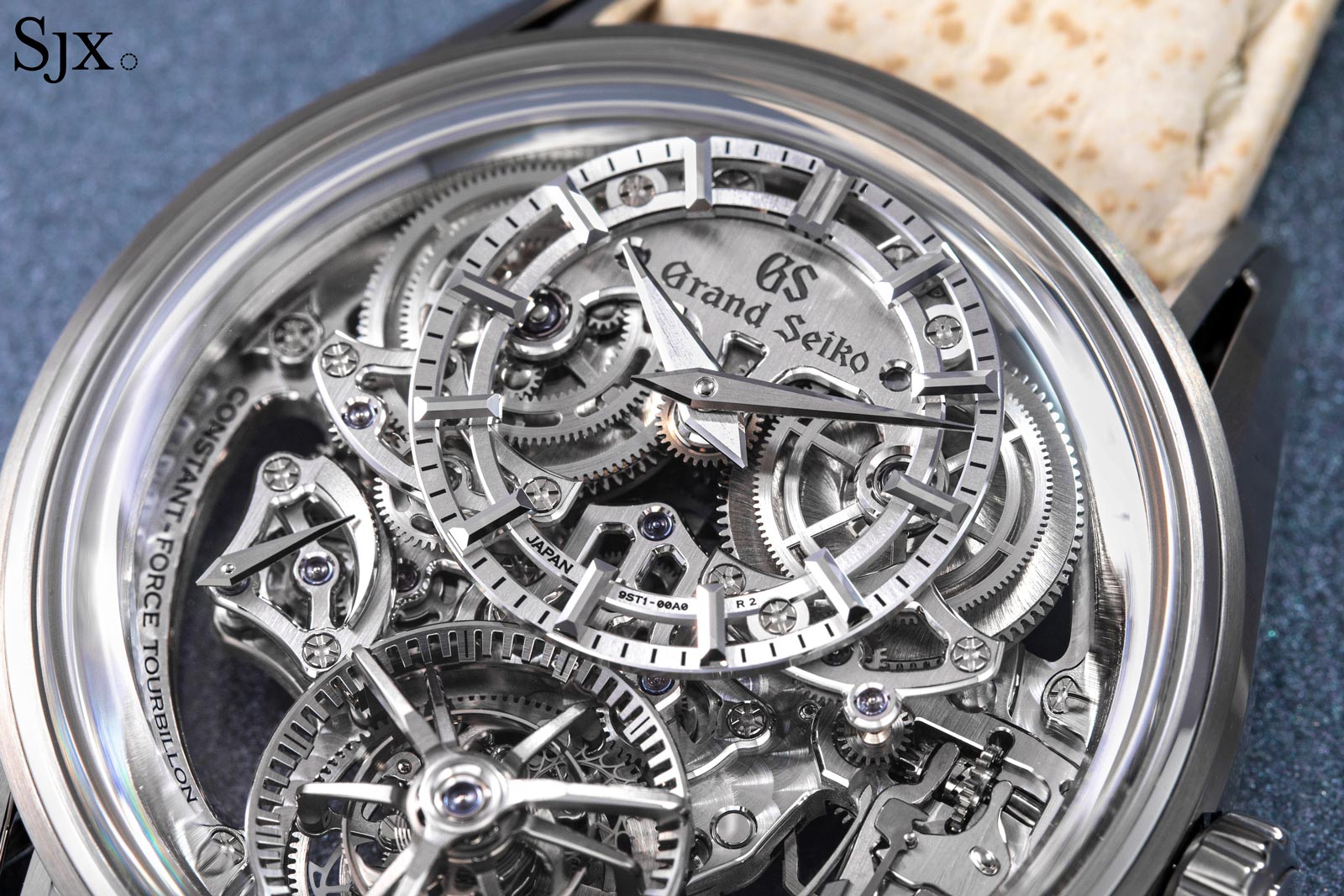
Despite the mass of mechanical detail on the front, it is still clear that the centre of the action is at six o’clock where the tourbillon sits. At first glance it appears to be a nine-armed tourbillon cage, but it is actually composed of two superimposed carriages under a three-armed bridge, for a total of nine arms across all of them.
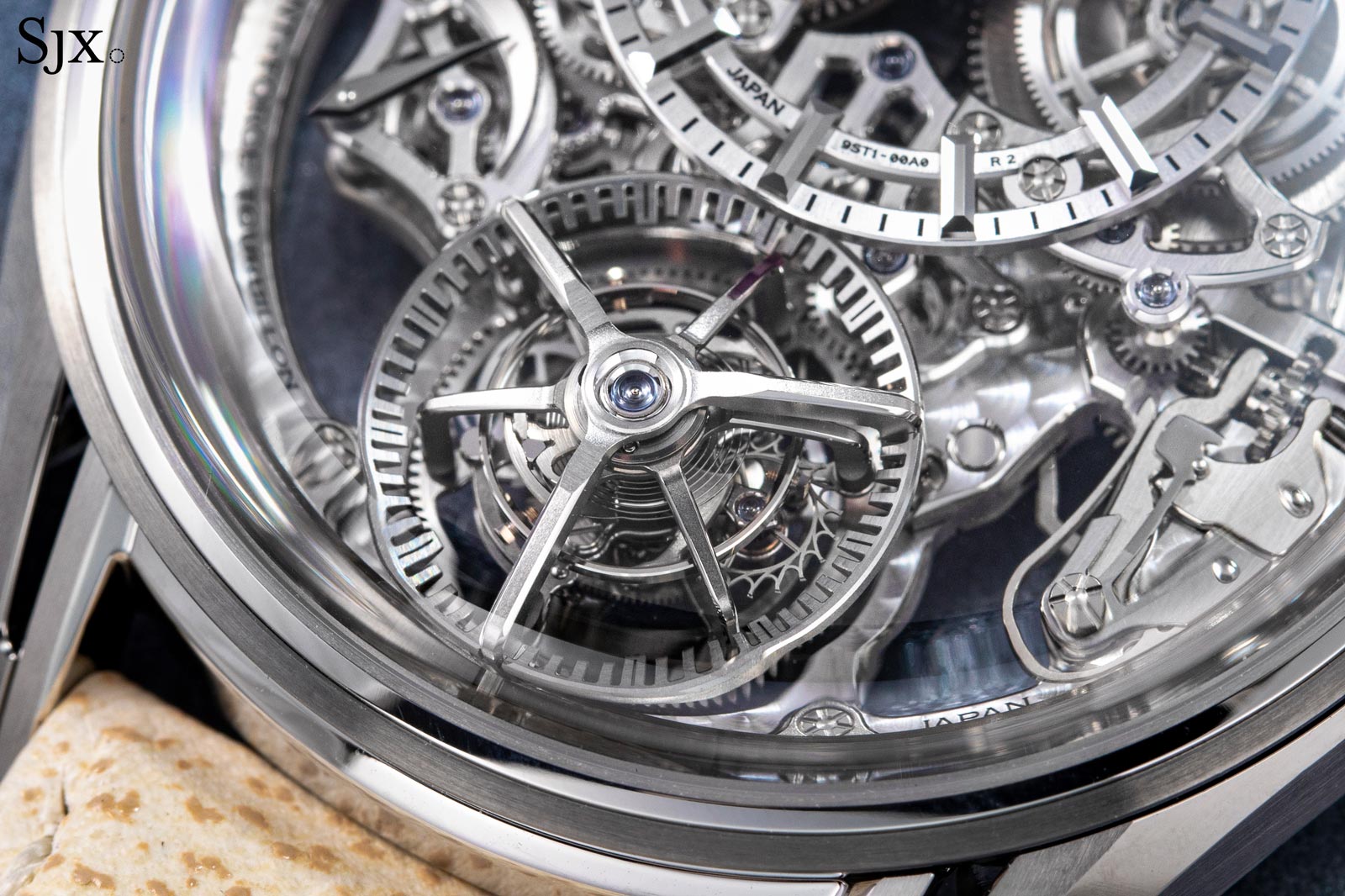
While the three armed bridge is fixed, the two inner cages rotate at different but synchronised rates. The inner carriage is the one-minute tourbillon, while the outer carriage is for the constant force mechanism, or remontoir. The remontoir wheel sits below the tourbillon cage, which means the remontoir encloses the tourbillon. Both the remontoir and tourbillon are thus co-axial.
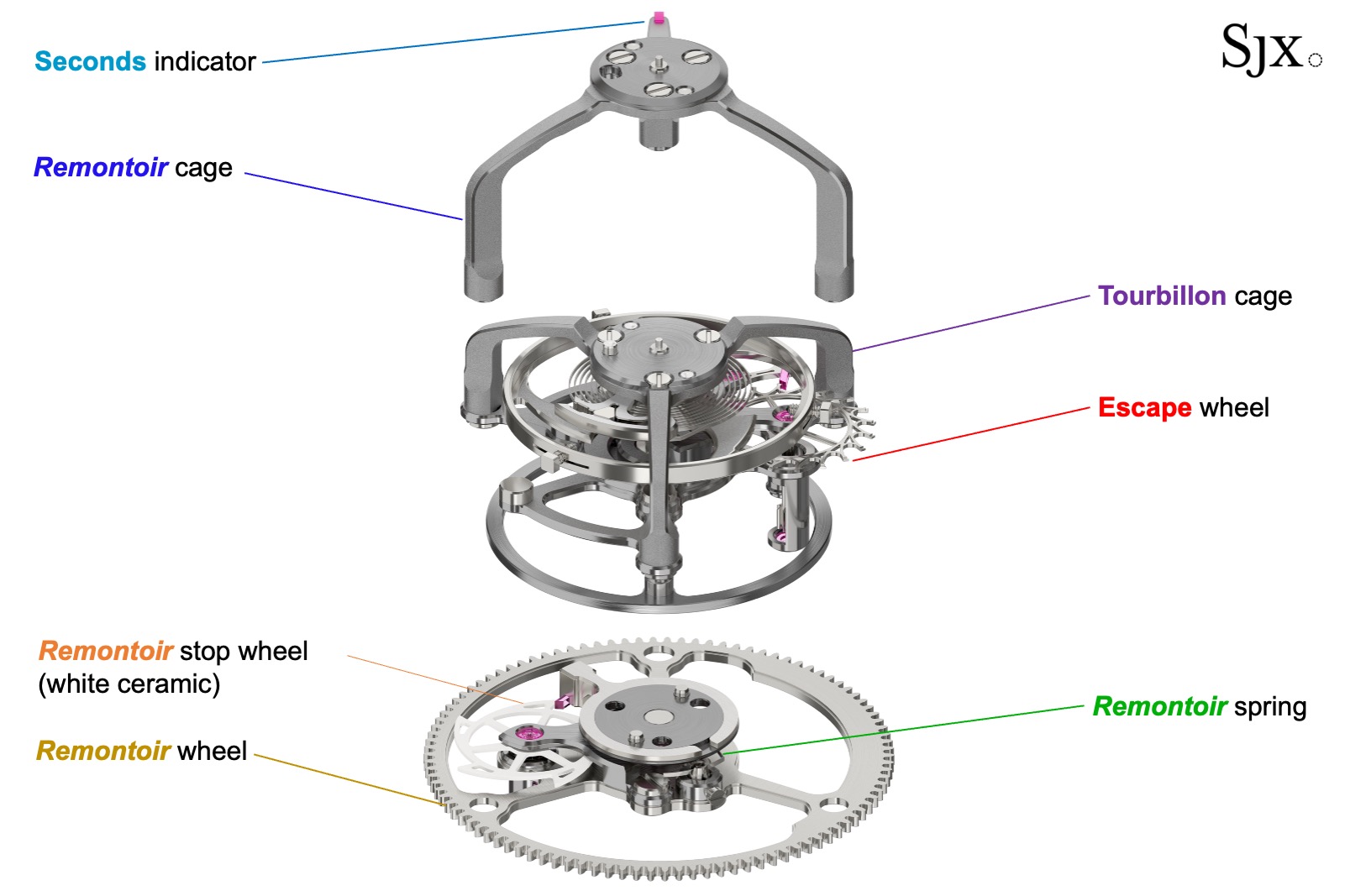
The remontoir delivers a constant impulse to the tourbillon once a second, with the remontoir cage making moving a discernible 1/6th step every second. The tourbillon makes one revolution a minute, advancing a 1/60th step every second. All the while, the balance wheel within oscillates at 4 Hz, or 28,800 beats per hour, which is unusually high for a tourbillon but promises better rate stability.
Together, the synchronised beat forms a “16th note rhythm” according to the Kodo’s constructor, engineer Takuma Kawauchiya. And that is the basis of kodo, which is “heartbeat” in Japanese.
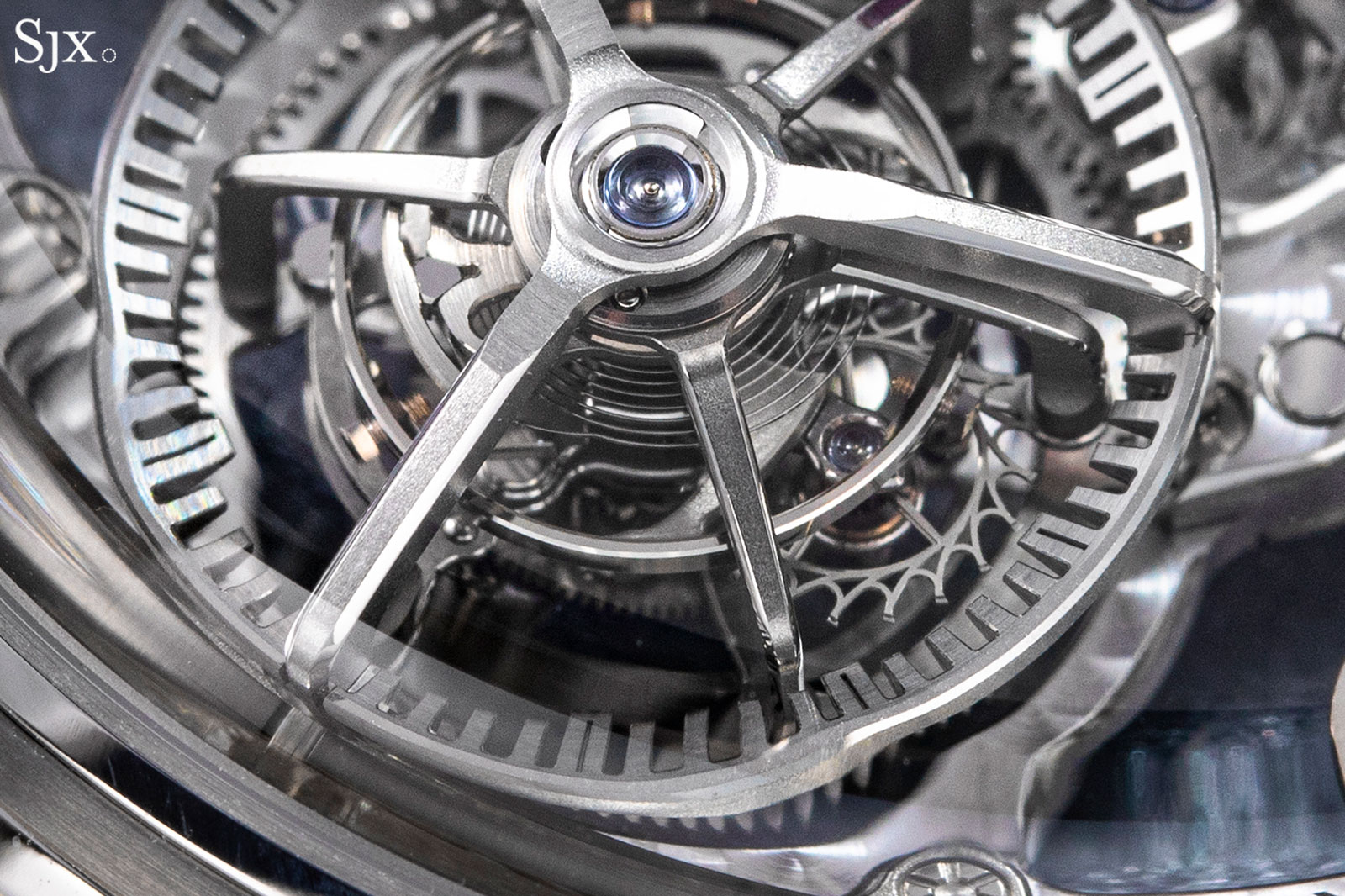
The tourbillon relies on a lightweight, skeletonised escape wheel made via the MEMS lithography technique
And the tourbillon also hacks, not merely by stopping the balance, but the carriage. This is a notable achievement as stopping the balance is easier, making it the more common approach.
To do this, a small spring tangentially touches the carriage when the crown is pulled to set the time, stopping the movement; the very same spring then nudges the carriage to get it going again when the crown is pushed back then.
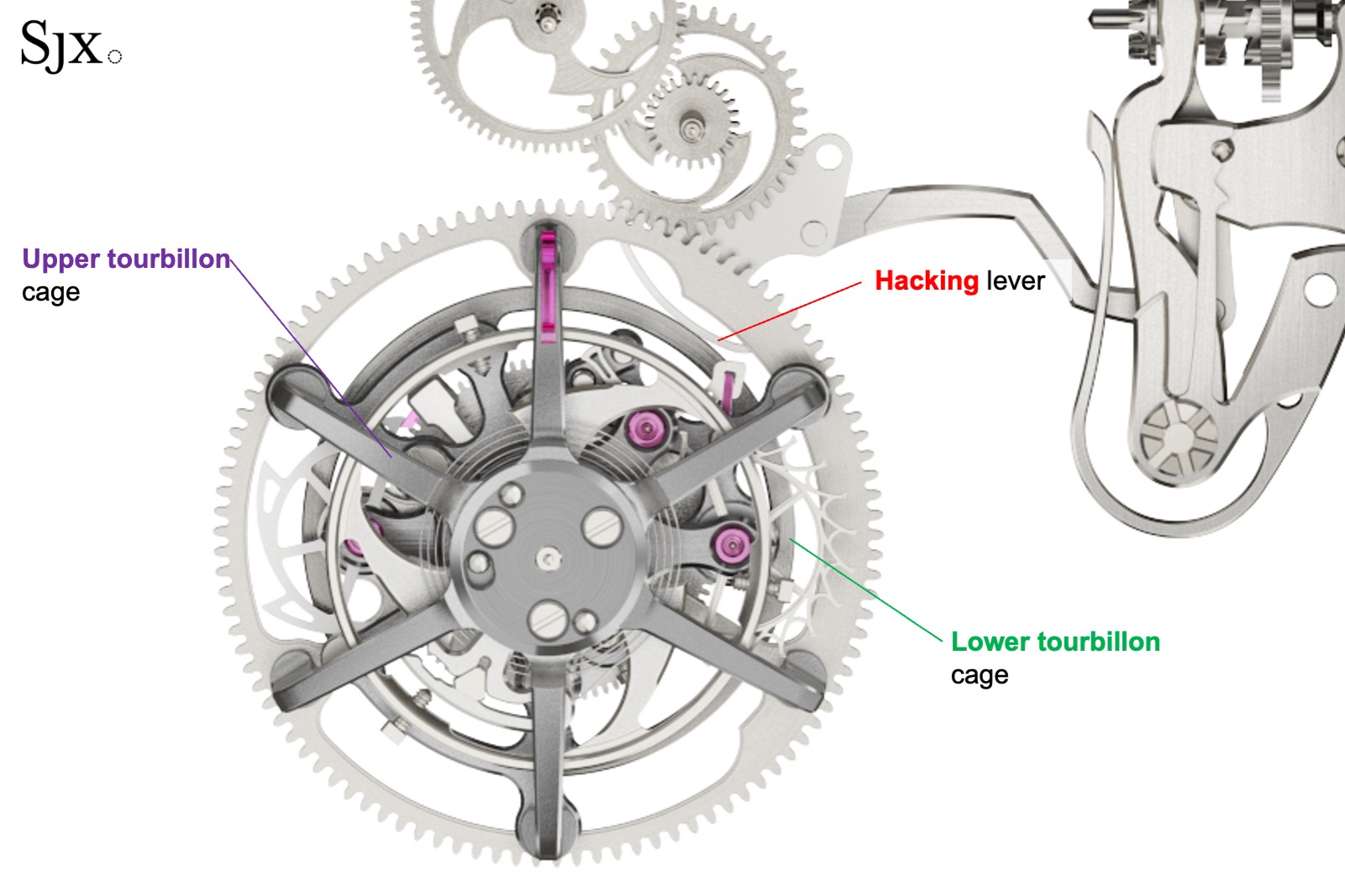
On the back, the movement looks a bit more traditional, though it has a few anime-style details like the shuriken-form barrel ratchet wheels.
Appropriately enough, the bridges are decorated with concentric striping radiating outwards from the “heart” of the watch, or more specifically the lower pivot of the tourbillon. This is classical, as is the grande sonnerie-style winding click for the barrels.
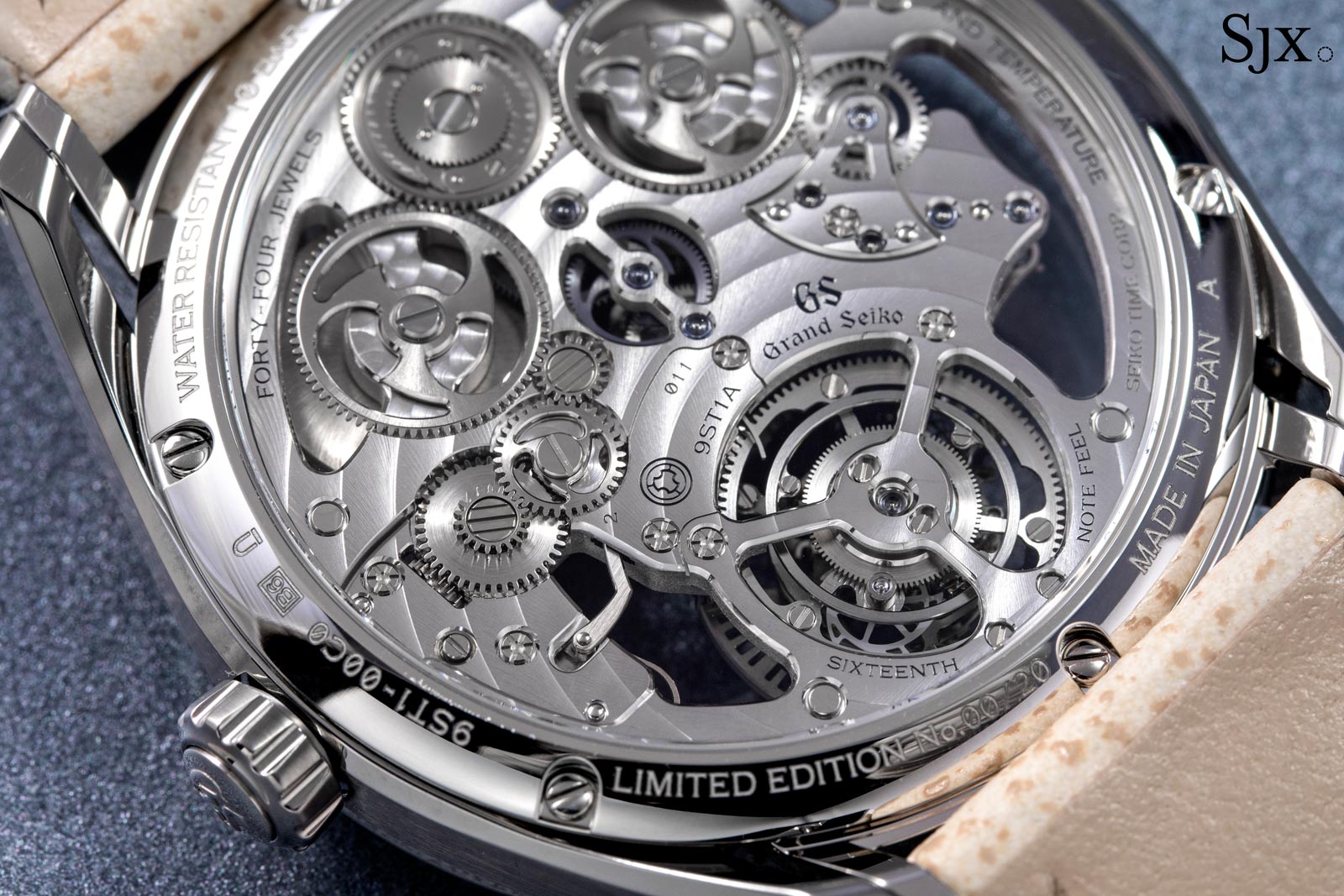
But the aesthetic is still modern, echoing the front, but to a less extreme degree. Even though the bridge is large, akin to a base plate, various apertures and inlaid bridges create an high level of mechanical detail. The wheels with spiral spokes, some of them sharp like a ninja star, continue the highly stylised design that defines the dial.
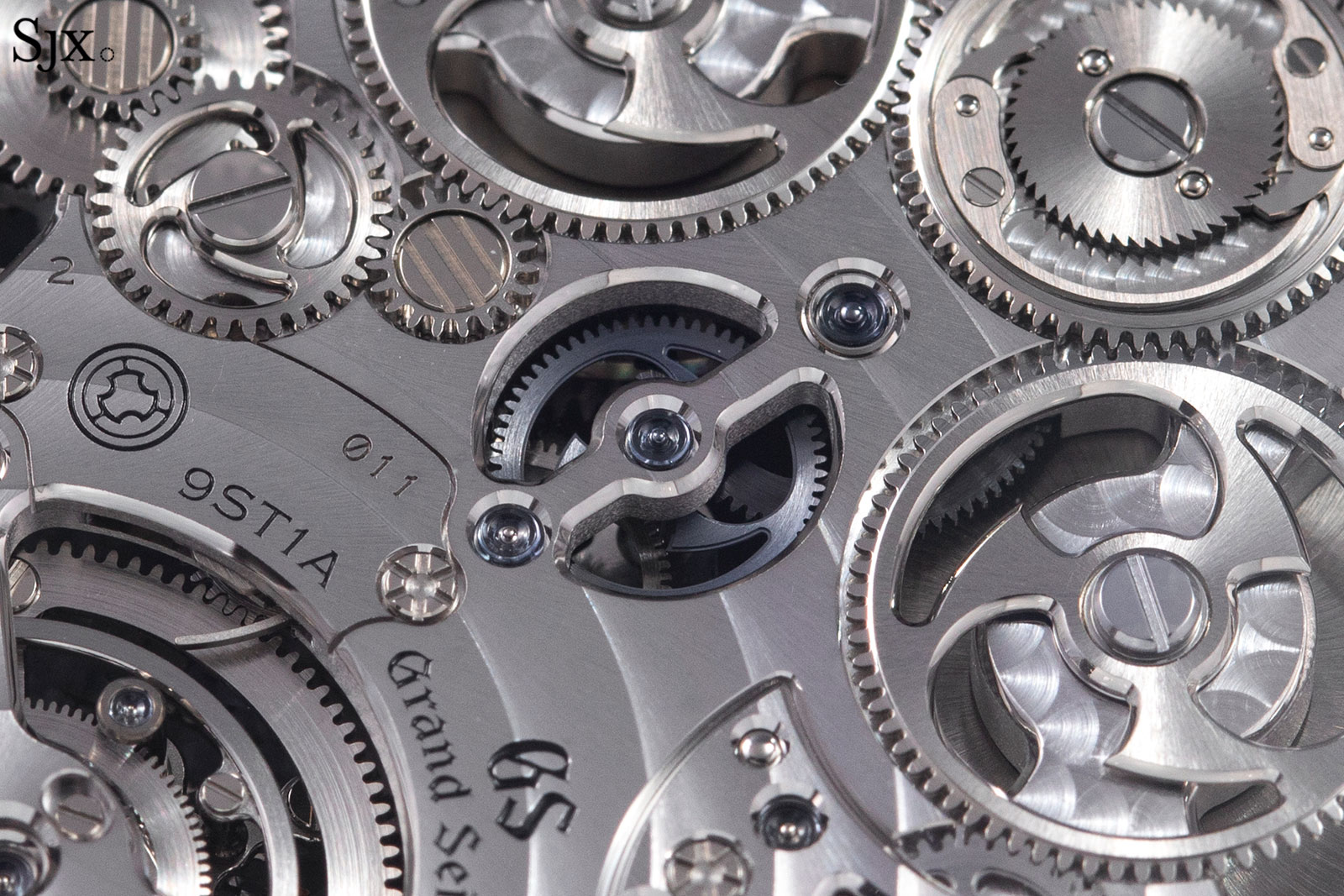
While the design is clear modern, the finishing is traditional. Indeed one of the goals during the development of the Kodo was to achieve high-end movement decoration akin to that found in haute horlogerie Swiss watches.
Go deeper beyond the bold design and you’ll find rounded, mirror-polished bevelling along all edges – and there are a lot of edges as a result of the thorough skeletonisation. The anglage includes the requisite inward angles, and even extends to the elements several layers down that are barely visible.
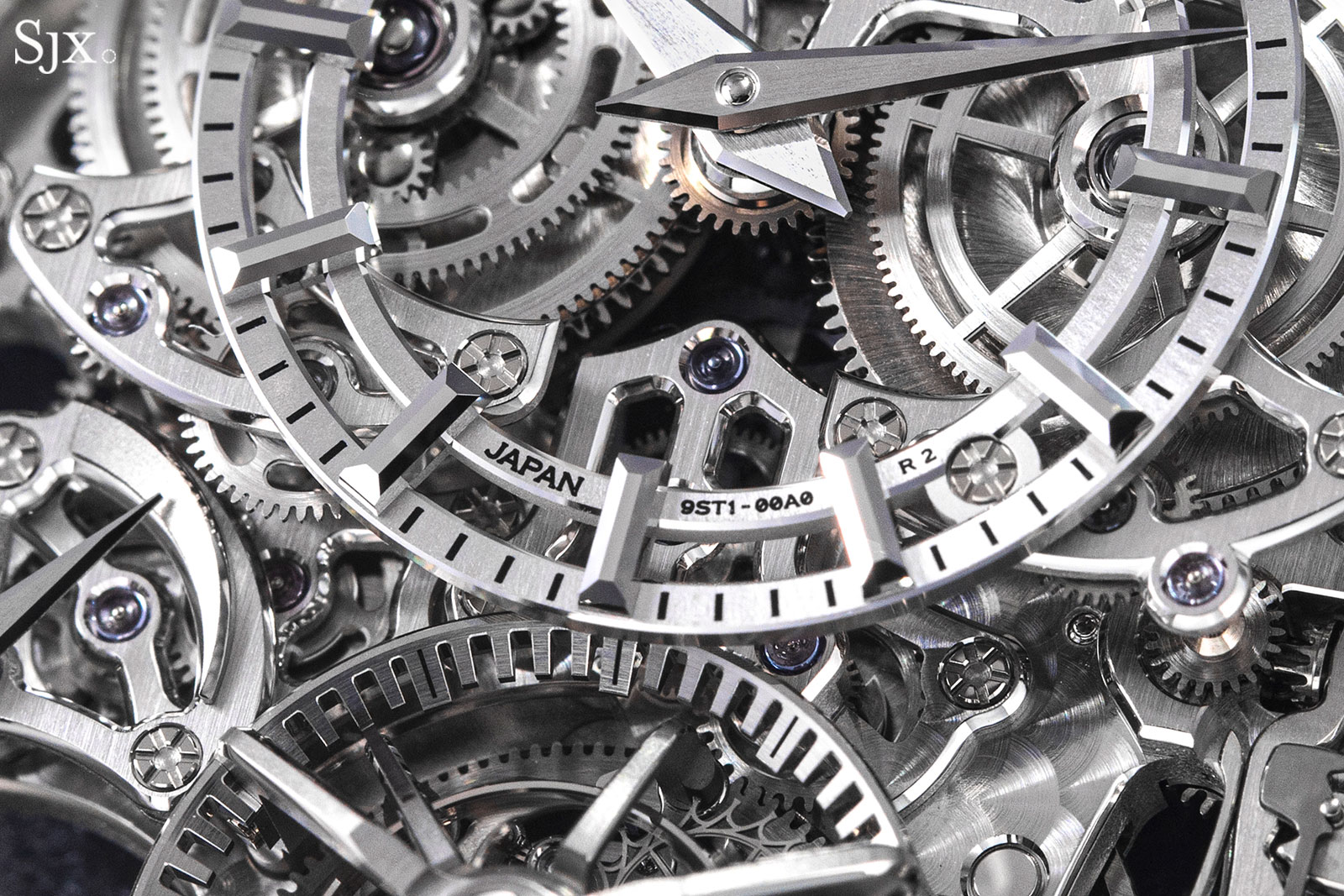
The decoration also includes the expected chamfered teeth for the larger wheels, polished countersinks, and polished pins. One of the most impressive examples of the decoration can be found on the twin barrel ratchet wheels that are so sharply formed they are convincing as miniature shuriken.
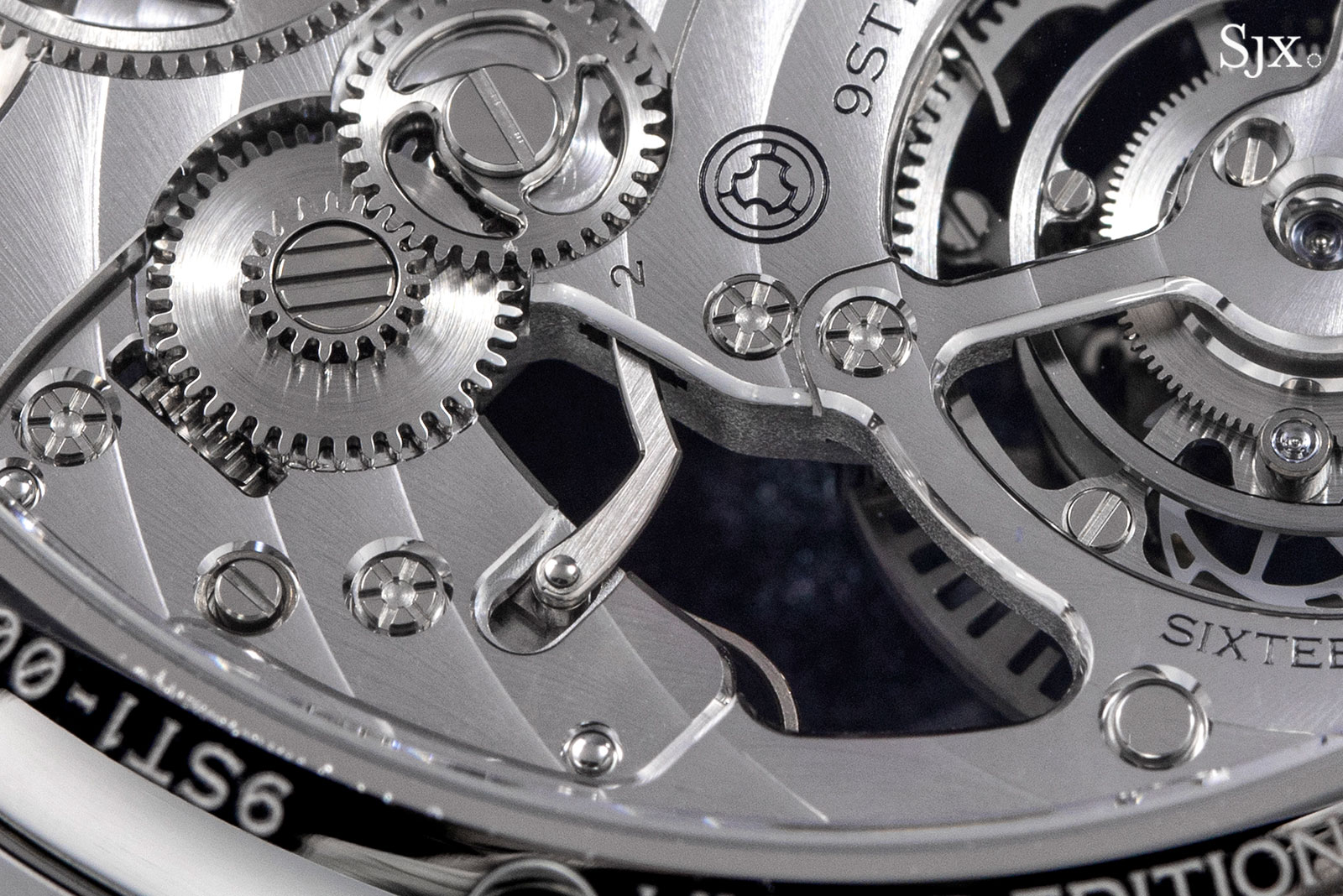
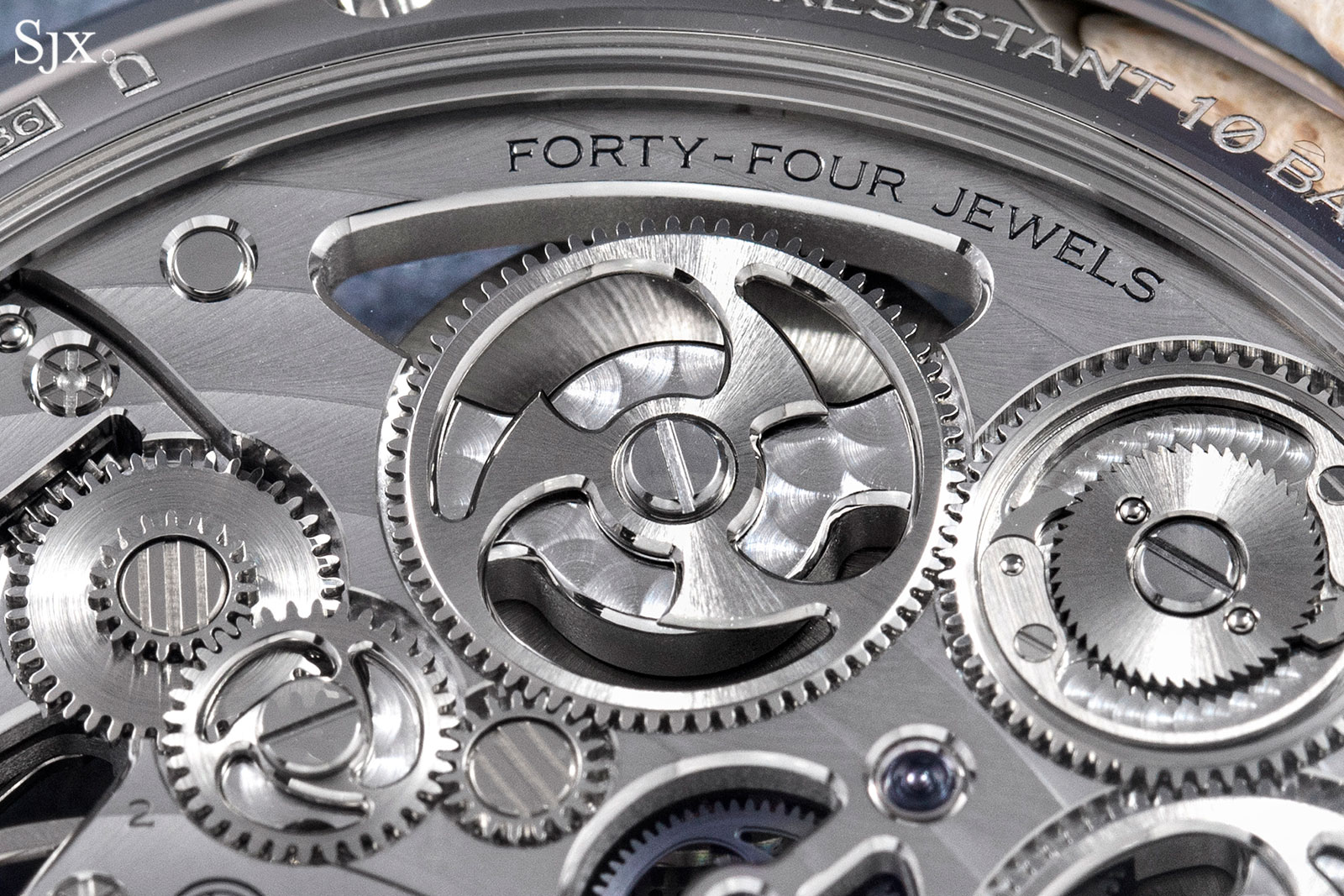
Concluding thoughts
Although the new Kodo is essentially identical to the original, the “light” look is more compelling, particularly in relation to the distinct style of the movement. Design aside, the Kodo SLGT005 retains all of the technical and decorative appeal of the original.
Key facts and price
Grand Seiko Kodo Constant-Force Tourbillon “Daybreak”
Ref. SLGT005
Diameter: 43.8 mm
Height: 12.9 mm
Material: 950 platinum and Brilliant Hard Titanium
Crystal: Sapphire
Water resistance: 10 bar
Movement: Cal. 9ST1
Functions: Hours, minutes, dead-beat seconds, tourbillon with constant-force mechanism
Winding: Manual wind
Frequency: 28,800 vibrations per hour (4 Hz)
Power reserve: 72 hours
Strap: Calf strap with platinum folding buckle, and additional double-sided crocodile strap
Limited edition: 20 pieces
Availability: Starting December 2024 from Grand Seiko’s retailers and boutiques
Price: US$365,000; or 45 million Japanese yen before tax
For more, visit grand-seiko.com.
Back to top.
